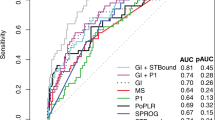Abstract
Background
The aim was to compare two perimetric strategies for progression detection in glaucoma.
Methods
Two perimetric strategies for progression detection were compared by means of a thought experiment in a theoretical cohort. In strategy I, visual field testing is performed with fixed-space inter-test intervals at a frequency of two tests per year. In strategy II, the frequency of visual field testing is set to one test per year as long as the fields are apparently unchanged, whereas as soon as progression is suspected, confirmation or falsification is performed within a short time span. Outcome measures were the time delay between the progression event and the diagnosis of definite progression, and the number of visual field tests performed per patient per year.
Results
Average time delay between the actual progression event and the final diagnosis of definite progression was 15 months in the case of strategy I and 6 months in the case of strategy II. Maximum time delays were 18 and 12 months respectively. The frequency of visual field testing was 2 tests per patient per year for strategy I and 1.45 tests per patient per year for strategy II.
Conclusions
Perimetry in glaucoma can be optimised by postponing the next test in the case of an apparently stable field and accelerating the next test in the case of a suspected progression. This results in an earlier diagnosis, a lower perimetric frequency and a shorter period of uncertainty for the patient.

Similar content being viewed by others
References
AGIS Investigators (1994) Advanced glaucoma intervention study. II. Visual field test scoring and reliability. Ophthalmology 101:1445–1455
Gardiner SK, Crabb DP (2002) Frequency of testing for detecting visual field progression. Br J Ophthalmol 86:560–564
Heijl A, Leske MC, Bengtsson B, Hyman L, Bengtsson B, Hussein M, EMGT group (2002) Reduction of intraocular pressure and glaucoma progression. Arch Ophthalmol 120:1268–1279
Jansonius NM (2005) Bayes' theorem applied to perimetric progression detection in glaucoma: from specificity to positive predictive value. Graefes Arch Clin Exp Ophthalmol 243:433–437
Lee AC, Sample PA, Blumenthal EZ, Berry C, Zangwill L, Weinreb RN (2002) Infrequent confirmation of visual field progression. Ophthalmology 109:1059–1065
Leske MC, Heijl A, Hyman L, Bengtsson B, EMGT group (1999) Early manifest glaucoma trial: design and baseline data. Ophthalmology 106:2144–2153
Musch DC, Lichter PR, Guire KE, Standardi CL (1999) The collaborative initial glaucoma treatment study: study design, methods, and baseline characteristics of enrolled patients. Ophthalmology 106:653–662
Smith SD, Katz J, Quigley HA (1996) Analysis of progressive change in automated visual fields in glaucoma. Invest Ophthalmol Vis Sci 37:1419–1428
Spry PGD, Johnson CA (2002) Identification of progressive glaucomatous visual field loss. Surv Ophthalmol 47:158–173
Viswanathan AC, Hitchings RA, Fitzke FW (1997) How often do patients need visual field tests? Graefes Arch Clin Exp Ophthalmol 235:563–568
Author information
Authors and Affiliations
Corresponding author
Rights and permissions
About this article
Cite this article
Jansonius, N.M. Towards an optimal perimetric strategy for progression detection in glaucoma: from fixed-space to adaptive inter-test intervals. Graefe's Arch Clin Exp Ophthalmo 244, 390–393 (2006). https://doi.org/10.1007/s00417-005-0032-5
Received:
Revised:
Accepted:
Published:
Issue Date:
DOI: https://doi.org/10.1007/s00417-005-0032-5




